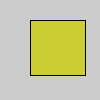| Name | << (left shift) |
||||
|---|---|---|---|---|---|
| Examples |
m = 1 << 3 # In binary: 1 to 1000 print(m) # Prints "8" n = 1 << 8 # In binary: 1 to 100000000 print(n) # Prints "256" o = 2 << 3 # In binary: 10 to 10000 print(o) # Prints "16" p = 13 << 1 # In binary: 1101 to 11010 print(p) # Prints "26" 
# Packs four 8 bit numbers into one 32 bit number a = 255 # Binary: 00000000000000000000000011111111 r = 204 # Binary: 00000000000000000000000011001100 g = 204 # Binary: 00000000000000000000000011001100 b = 51 # Binary: 00000000000000000000000000110011 a = a << 24 # Binary: 11111111000000000000000000000000 r = r << 16 # Binary: 00000000110011000000000000000000 g = g << 8 # Binary: 00000000000000001100110000000000 # Equivalent to "color argb = color(r, g, b, a)" but faster argb = a | r | g | b fill(argb) rect(30, 20, 55, 55) | ||||
| Description | Shifts bits to the left. The number to the left of the operator is shifted the number of places specified by the number to the right. Each shift to the left doubles the number, therefore each left shift multiplies the original number by 2. Use the left shift for fast multiplication or to pack a group of numbers together into one larger number. Left shifting only works with integers or numbers which automatically convert to an integer such as byte. | ||||
| Syntax | value << n | ||||
| Parameters |
| ||||
| Related |
>> (right shift) |
Updated on Mon Sep 21 15:53:25 2020.
If you see any errors or have comments, please let us know.

This work is licensed under a Creative Commons Attribution-NonCommercial-ShareAlike 4.0 International License